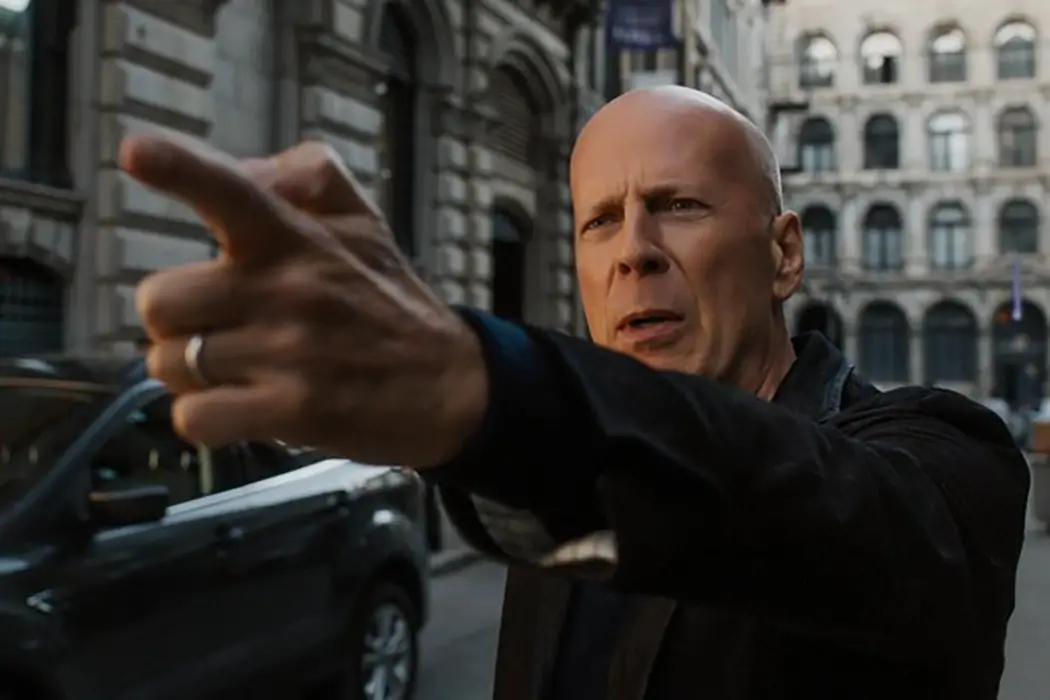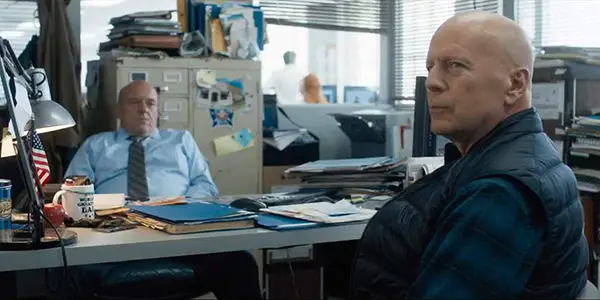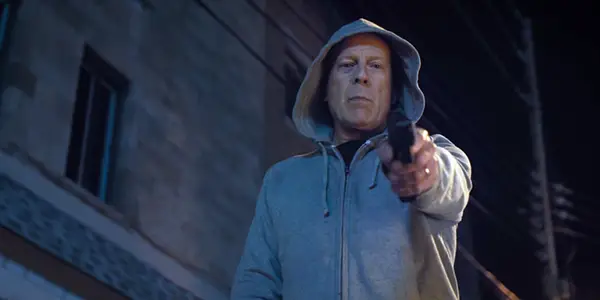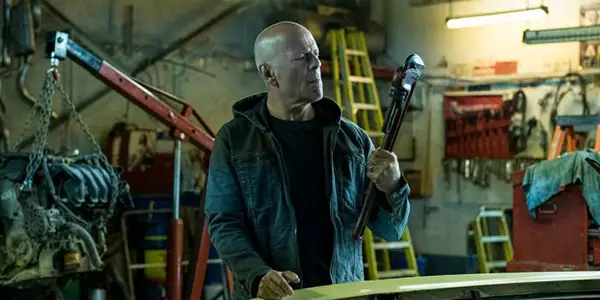DEATH WISH: A Poorly Timed, Generic Remake

David is a film aficionado from Colchester, Connecticut. He enjoys…
It is sometimes impossible to think of certain films without specifically narrowing in on the sociopolitical environments from which they emerged. 1974 gave us the original Death Wish, a film about a man living in New York City who takes it upon himself to rid the streets of corruption after the murder of his wife. At the time, NYC was undergoing a heightened period of violence and murder, one of its worst in modern history, and the film’s celebration of vigilantism is in response to this.
Now, 44 years later, director Eli Roth has tackled the story once again, moving the location to Chicago and placing Bruce Willis in the role originated by Charles Bronson. Both films are clearly controversial, and celebrate the vigilante who takes the law into his own hands. But where the original Death Wish was at least analogous to the turmoilic times, this remake, especially with a rising public stigma against guns after the Parkland shooting, already feels outdated. Much like the original film, this version of Death Wish will, in this case unfortunately, be forever associated to the current times.
From NYC to Chicago
Death Wish is set in Chicago in the present day. It is focused on the Kersey family, which includes Paul (Bruce Willis), his wife Lucy (Elizabeth Shue), and their soon to be college-bound daughter Jordan (Camila Morrone). Paul is a renowned surgeon, and is often called into work unexpectedly as a result of his profession. One night while Paul is out, his family home is burglarized by a trio of criminals, and in the process, both Lucy and Jordan are shot. Lucy does not survive the attack, while Jordan falls into a coma as a result of her injuries.

Paul is reassured that they will find his wife’s killer by Detective Kevin Raines (Dean Norris, who is basically playing Hank from Breaking Bad). Yet, after some time goes by, Kersey is unsatisfied at how little progress there has been in that direction. Finding himself a gun, he takes to the crime-strewn streets in hopes of somehow finding the men responsible for destroying his family.
Knowing the original story, none of this is particularly unexpected, but the exposition of Death Wish is still surprisingly clunky. The film begins by showing the family gleefully celebrating after Jordan gets into college in New York and subsequently start to talk about her plans, manipulating us as the audience into caring when we know what is coming. In addition, we are constantly told that murder and violent crime is rampant in Chicago (in case you haven’t seen the news in the last few years), as the constant stream of radio broadcasts like to tell us. It’s one of the more blatant examples of foreshadowing that I have seen in recent years, with little nuance or subtlety, which only sets the tone for the film to come.
Modernization and Genericness
Like most modern remakes, the story of Death Wish is updated by including modern technology. Here, we have a use of a cellphone video uploaded to YouTube which captures Paul Kersey’s initial vigilante act, which shows him brutally taking out a van full of people attempting to kidnap a girl, earning him the nickname “The Grim Reaper.” Yet, this detail is one of the only distinctions in this adaptation of the story.
One of the more controversial aspects of the original Death Wish is that Kersey’s decision to take to the streets, though motivated initially by the loss of his wife, soon starts to turn into a generalized spree of violence, in which he indiscriminately takes out anyone committing even the smallest of crimes. His motivations soon become less about retribution for his wife and more just his force for justice across the city.

Willis‘ Kersey is initially motivated by this same reasoning, but where the film then juts off from this is what makes it far less compelling. Soon, Kersey starts to find clues about the identity of the people who had murdered his wife, and as opposed to still taking to the streets to take out criminals, he goes on a vendetta against them personally. As a result, the film becomes simply a generic run-of-the-mill revenge thriller, with little reason to delve further into the psyche of the protagonist as we were forced to in the original.
1974’s Death Wish, or Taxi Driver which came two years later, work because they are unafraid to dive into the darkness of a damaged and twisted individual. It’s strange that Roth and screenwriter Joe Carnahan decided to go a decidedly safer route, as it makes the film somehow less controversial in some ways than one that came out over 4 decades ago.
Wasted Cast
Seeing that Bruce Willis would be cast in Death Wish at least gave me some hope, especially given his lack of starring roles in recent years. In addition, action roles are obviously his specialty, with the Die Hard series in particular (we won’t mention Die Hard 5). It’s unfortunate, then, that outside of a couple brief action moments, Death Wish doesn’t utilize the best of Willis‘ star power. Willis is clearly capable of emotionally resonant characters, seen in such films as The Sixth Sense or even Unbreakable, but Death Wish instead presents him as dry and vacuous, with little chance to show his charismatic appeal.
Other wasted cast members include Vincent D’Onofrio, who plays Kersey’s brother, and seemingly is in the film simply for one brief moment towards the ending. Two great actors like this could have had some great scenes to play off each other, but instead the film is far more concerned in showing unnecessarily long (and unbelievable) gunfights.
Violence, Guns, and Current Times
Eli Roth, perhaps best known as the director of the first two Hostel films, has become synonymous with the creation of “torture porn,” a subgenre of horror that gratuitously shows gore in an attempt to illicit a disgusted response from viewers. And in Death Wish, he’s no different. In the film, there is one truly nasty scene of torture from Kersey as he is trying to get information from someone, which is likely also the reason that Kersey’s profession is presented as a surgeon as opposed to an architect as he is in the original.

The film’s use of gore and excessive violence, though, is only exacerbated by our current political environment. Premiering only 16 days after one of the worst mass school shootings in history, it presents a glorification of violence, a worshiping of guns, and an idolization of a man who takes the law into his own hands. In an environment where public sentiment seems to finally be changing in regards to more firm gun control, the film just feels wildly out of place.
Conclusion: Death Wish
Though the focus on crime-strewn Chicago does seem like a way of trying to recapture the public sentiment that existed back in the 1970s when the original Death Wish emerged, it’s still easy to tell that this remake doesn’t adapt to our times. It fails to modernize the outdated ideas presented in the original film, and in addition, feels even more generic with its eventual revenge story focus. The original Death Wish started a franchise; but this new version will likely be remembered as an unfortunate remnant of political sentiment gone wrong.
What are your thoughts on Death Wish? Do you agree that this remake is an example of poor timing?
Death Wish was released in the U.S. on March 2, 2018 and will be released in the UK on April 6. For all international release dates, click here.
Does content like this matter to you?
Become a Member and support film journalism. Unlock access to all of Film Inquiry`s great articles. Join a community of like-minded readers who are passionate about cinema - get access to our private members Network, give back to independent filmmakers, and more.
David is a film aficionado from Colchester, Connecticut. He enjoys writing, reading, analyzing, and of course, watching movies. His favorite genres are westerns, crime dramas, horror, and sci-fis. He also enjoys binge-watching TV shows on Netflix.













